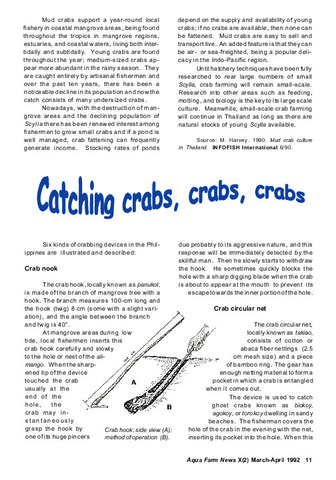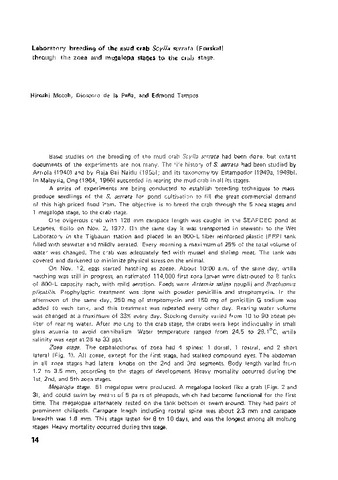Mud crab nursery rearing practices
| dc.contributor.author | Parado-Estepa, Fe D. | |
| dc.contributor.author | Quinitio, Emilia T. | |
| dc.contributor.author | Rodriguez, Eduard M. | |
| dc.contributor.editor | Quinitio, Emilia T. | |
| dc.contributor.editor | Estepa, Fe Dolores P. | |
| dc.contributor.editor | Thampi Sam Raj, Yohannan C. | |
| dc.contributor.editor | Mandal, Anup | |
| dc.date.accessioned | 2017-09-04T10:09:18Z | |
| dc.date.accessioned | 2017-09-04T10:40:11Z | |
| dc.date.accessioned | 2017-09-05T08:48:38Z | |
| dc.date.available | 2017-09-04T10:09:18Z | |
| dc.date.available | 2017-09-04T10:40:11Z | |
| dc.date.available | 2017-09-05T08:48:38Z | |
| dc.date.issued | 2015 | |
| dc.identifier.citation | Parado-Estepa, F. D., Quinitio, E. T., & Rodriguez, E. M. (2015). Mud crab nursery rearing practices. In E. T. Quinitio, F. D. Parado-Estepa, Y. C. Thampi Sam Raj, & A. Mandal (Eds.), Proceedings of the International Seminar-Workshop on Mud Crab Aquaculture and Fisheries Management, 10-12 April 2013, Tamil Nadu, India (pp. 89-92). Tamil Nadu, India: Rajiv Gandhi Centre for Aquaculture (MPEDA). | en |
| dc.identifier.isbn | 9788192989815 | |
| dc.identifier.uri | http://hdl.handle.net/10862/3214 | |
| dc.description.abstract | The need for seeds for expansion of the mud crab industry led to the development of the hatchery technology. The nursery technology was developed as this served as a link between the hatchery, which produces megalopae or early crab instars, and the grow-out phase which requires bigger crab juveniles for a higher yield. The nursery has two phases, the first ending with production of crablets with 1- 1.5 cm carapace width (CW) and the second phase with crablets of 2.5-3.0 cm ICW. The more commonly recommended system employs stocking of megalopae or crab instars in net cages installed in ponds. Locally available unprocessed food and commercially available shrimp formulated diet are used for feeding. However, recent studies have successfully used formulated nursery diet for mud crab. One of the main problems in the nursery is cannibalism, and several strategies have been investigated and tried to address the problem. | en |
| dc.language.iso | en | en |
| dc.publisher | Rajiv Gandhi Centre for Aquaculture (MPEDA) | en |
| dc.subject | Mud crab | en |
| dc.subject | Net cages | en |
| dc.subject | Formulated feed | en |
| dc.subject | Trimming of claws | en |
| dc.title | Mud crab nursery rearing practices | en |
| dc.type | Conference paper | en |
| dc.citation.spage | 89 | |
| dc.citation.epage | 92 | |
| dc.citation.conferenceTitle | Proceedings of the International Seminar-Workshop on Mud Crab Aquaculture and Fisheries Management, 10-12 April 2013, Tamil Nadu, India | en |
| dc.subject.asfa | cannibalism | en |
| dc.subject.asfa | nursery ponds | en |
| dc.subject.asfa | crab culture | en |
| dc.subject.asfa | rearing techniques | en |
| dc.subject.asfa | cage culture | en |
このアイテムのファイル
| ファイル | サイズ | フォーマット | 閲覧 |
|---|---|---|---|
|
このアイテムに関連するファイルは存在しません。 |
|||
このアイテムは次のコレクションに所属しています
-
International Seminar-Workshop on Mud Crab Aquaculture and Fisheries Management (ISMAF 2013) [15]
Proceedings of the International Seminar-Workshop on Mud Crab Aquaculture and Fisheries Management, 10 - 12 April 2013



